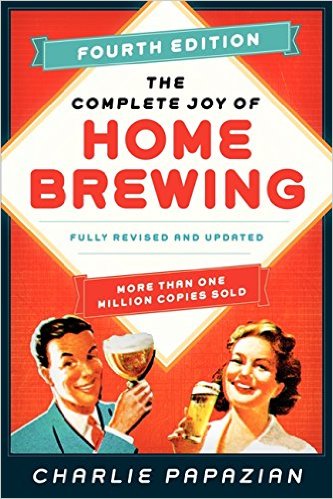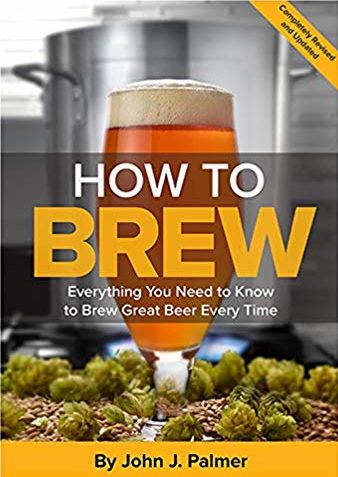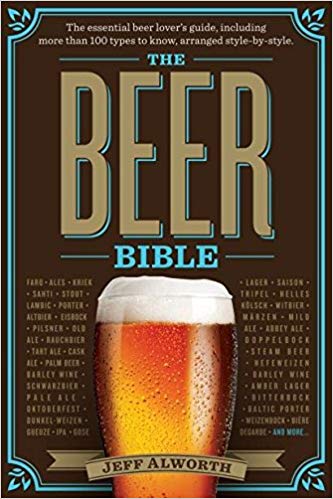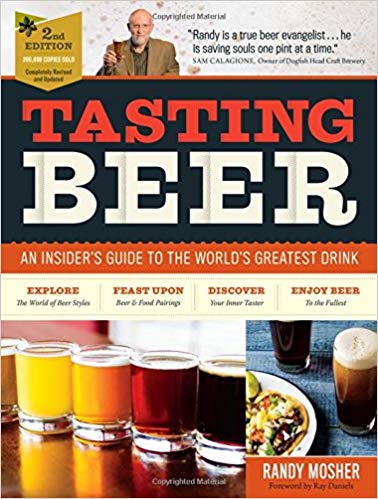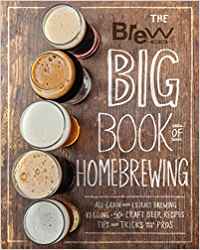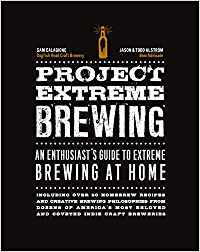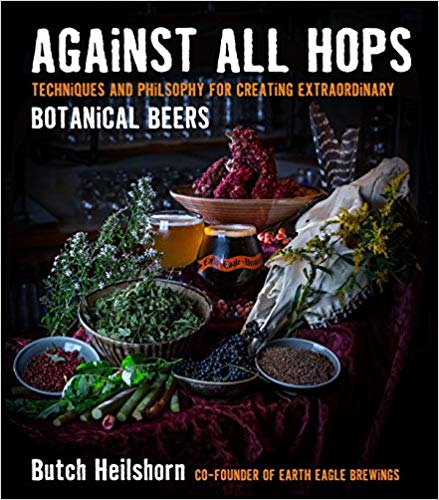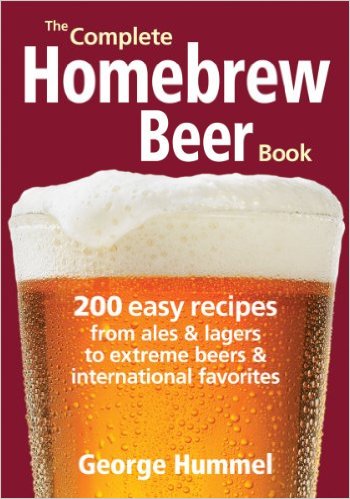Books that will help you make amazing beer at home
I thought it would be helpful to archive the books that have had the greatest impact on my brewing skills. These books have been thumbed-through and referenced religiously. I recommend them all. They make great gifts for any aspiring brewer! As always, if you have any questions about these, send me a note. Enjoy!
[Full Disclosure: As an Amazon affiliate, I receive compensation if you purchase through the links below — it helps me pay for the hosting costs of BeerCraftr and it costs you nothing.]
1. The Complete Joy of Homebrewing by Charlie Papazian
This is the book that got me started (and hooked) on the art of making craft beer. Charlie Papazian does a fantastic job of introducing newbies to the joy of home brewing. It’s an easy read and Papazian’s approach to brewing is one I have mimicked since I made my first batch.
Whenever I’m worried that I may have taken a wrong turn, or that I may have botched my beer, I think, WWCD, “What Would Charlie Do?” You know what he’d do? He’s tell you to “Relax. Don’t worry. Have a homebrew!” And he’s right. Brewing beer is fun. And it should always be fun. As you make your way through this book, you’ll find Papazian’s energy contagious; you’ll want to get brewing right away.
With Papazian, you’re in the hands of a master. He does an awesome job of getting you started, covering the basics, lessons for making good beer, countless recipes covering styles from around the world, tips on using honey, herbs and spices, and he’ll even the basics of all-grain brewing. This really is the beer crafter’s bible. It should be on the shelf of any aspiring brewer.
2. How to Brew by John Palmer
If Charlie Papazian is responsible for giving me the confidence to start brewing, John Palmer is the one who helped me dial in my processes and take my brewing to a whole new level.
While Papazian’s book is approachable, you’ll find that Palmer writes more like a scientist or an engineer; he takes a deeper dive into the science and precision of brewing. If you’re new to brewing, you may find the book intense at times, but it’s an invaluable resource that you can come back to over and over again. It won’t ever sit on your shelf collecting dust. I’ve always got more to learn from Palmer.
I recommend using this book to build on the knowledge you acquired in Papazian’s book. Some of the material will be repetitive, but you’ll find Palmer does a great job of giving you just a bit more information to chew on. After you’ve consumed this classic, you’ll start feeling like an expert; the science of brewing won’t sound nearly as intimidating as it may have before you read the book.
3. Designing Great Beers by Ray Daniels
My only regret with this book is that I only got it five years into my brewing hobby. This may be an old book, but it is absolutely timeless and indispensable. It also, in my view, serves as chapter three, if Papazian and Palmer are chapters one and two in your brewing education. Papazian gets you started; Palmer helps you level-up; Daniels helps you master classic beer styles.
Daniels taught me how to calculate my OG and how to correct it. He gave me my first lesson on mash pH. And he give me a whole new understanding of the chemistry of hop flavor and aroma. This book is intense. It may “only” be ~300 pages, but every paragraph contains a bomb of information. You’ll want to take your time with this book, but it’s worth the investment; you’ll have a whole new understanding of the brewing process.
4. The Beer Bible by Jeff Alworth
This book is as described: a wonderful reference guide for the beer geek you are. John Hall of Craft Beer and Brewing calls it “the only book you need to understand the world’s most popular beverage,” and I completely agree.
It’s the kind of book you could blaze through in a binge session because it’s beautifully written and covers the gamut of the topic in bite-size pieces. Or because every chapter comes in a bite-size piece, you can keep it on the coffee table and take in a chapter at your leisure and let the knowledge sink in at a measured pace. Either way, even if you’ve been brewing for years, you’ll find a treasure-trove of stories and history that’ll be new to you.
Alworth covers the basics, ensuring you have a grasp of beer history and the brewing process before walking you through 32 different beer styles (including ales, lagers, and wild ales). He completes the bible by giving you a primer on how to serve, store, and enjoy beer. It’s a great read.
5. Tasting Beer by Randy Mosher
As the title suggests, Randy Mosher forced me to slow down and really take the time to taste, savour, and evaluate the beers I was drinking. There’s absolutely nothing wrong with simply enjoying your beer and giving it a binary “I like it” or “I don’t” evaluation, but if you want to hone in on your craft and get to know your beer on a whole new level, Mosher’s book serves as the perfect platform to jump from.
He, of course, covers the basics of beer and its history, but that’s not why you want this book. You want it because he gives you a deeper appreciation of your sensory skills. You’ll learn how your tongue receives and interprets different tastes and is; you’ll expand your sensory vocabulary; and my favourite part, learn how to evaluate your beer.
Mosher has such an approachable writing style, laced with enough wit to keep you on your toes. I highly recommend this one.
6. Big Book of Homebrewing
By the time you get through Papazian and Palmer’s books, the how-to section of this book will feel very repetitive, so I wouldn’t buy it as a starter guide. I’d instead get it for the 50+ clone recipes that you can adapt for your 1-gallon setup. Is it worth getting a book just for these recipes? Well, it depends on what you count among your favourite beers, but you’ll find many classic craft beer clones that you really can’t go wrong with.
Specifically: Sierra Nevada Pale Ale, The Alchemist Heady Topper, Allagash Tripel, Anchor Liberty Ale, Founder’s Breakfast Stout, Hill Farmstead Everett, New Belgium Fat Tire, Russian River Pliny the Elder (!)
Seriously, it’s worth it just for the recipes.
7. Project Extreme Brewing by Sam Calagione and Jason and Todd Alstrom
Once you have a couple of classic styles under your belt you’ll likely have the itch to try something off the beaten path. That’s where this book comes in. As with the homebrew handbook, the opening sections of this book will be repetitive; the real reason to get this book is to get inspired by the 50+ recipes in here from breweries who have been pushing the envelope with new beer styles and unconventional ingredients. The only drawback with the recipe collection is that some of them only contain extract versions. It’s not the end of the world, with a little bit of reverse engineering you can still convert those recipes into all-grain versions, but it seems like an oversight.
8. Against All Hops by Butch Heilshorn
If you really want to go extreme, try brewing without hops! Heilshorn is the co-founder of Earth Eagle Brewing and has a compelling call to action with this delightful book. “During our seven month foraging season, each gruit we brew is an authentic expression of time and place, our unique locale, our particular terroir. There are many brewers out there who believe as I do, that such expressions of time and place are the future of beer.”
After reading this book I was completely inspired to explore a wider range of herbs and spices and have recently begun planning out new recipes with locally-sourced ingredients. I now look at sage, rosemary, gale, and thyme in a totally new light. I also look at pig’s head in a new light. No joke, Heilshorn has a recipe in here that calls for a smoked pig’s head. If nothing else, this book will get you thinking and exploring the boundaries of beer (or gruit).
9. The Complete Homebrew Beer Book by George Hummel
Once you have the basics covered, you’ll want access to a wide library of recipes. That’s where George Hummel’s book comes in handy. You’ll have 200 recipes to choose from.
A big note here: these are partial mash recipes. You’ll be steeping a small number of grains to give your beer some character and colour, but you’ll be relying on malt extract to hit your target original gravity. While I have since switched to all-grain 1-gallon brewing, if you have not yet taken the all-grain plunge, these recipes are perfect. There’s a style here for everyone. Each recipe is detailed thoughtfully and most include tips specific to that recipe. It’s a great resource to have on hand, even for all-grain brewers. There are a lot of recipes to get inspired by in here.

